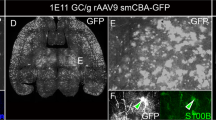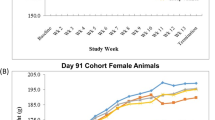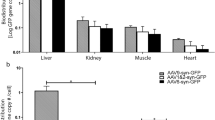Abstract
Adeno-associated virus (AAV)-6 or -9-pseudotyped vectors are suitable for efficient cardiac gene transfer after intravenous injection in mice. However, a systemic application in larger animals or humans would require very high doses of viral particles. Therefore, the aim of our study was to test if ultrasound-targeted microbubble destruction could augment cardiac transduction of AAV vectors after intravenous administration in rats. To analyze efficiency and specificity of gene transfer, microbubbles loaded with AAV-6 or -9 harboring a luciferase or enhanced green fluorescent protein (EGFP) reporter gene were infused into the jugular vein of adult Sprague–Dawley rats. During the infusion, high mechanical index ultrasound was administered to the heart. Control rats received the same amount of virus without microbubbles, but with ultrasound. After 4 weeks, organs were harvested and analyzed for reporter gene expression. In contrast to low cardiac expression after systemic transfer of the vector solution without microbubbles, ultrasound-targeted destruction of microbubbles significantly increased cardiac reporter activities between 6- and 20-fold. Analysis of spatial distribution of transgene expression using an AAV-9 vector encoding for EGFP revealed transmural expression predominantly in the left ventricular anterior wall. In conclusion, ultrasound targeted microbubble destruction augments cardiac transduction of AAV vectors in rats. This approach may be suitable for efficient, specific and noninvasive AAV-mediated gene transfer in larger animals or humans.
This is a preview of subscription content, access via your institution
Access options
Subscribe to this journal
Receive 12 print issues and online access
$259.00 per year
only $21.58 per issue
Buy this article
- Purchase on Springer Link
- Instant access to full article PDF
Prices may be subject to local taxes which are calculated during checkout





Similar content being viewed by others
References
Bekeredjian R, Shohet RV . Cardiovascular gene therapy: angiogenesis and beyond. Am J Med Sci 2004; 327: 139–148.
Muller OJ, Katus HA, Bekeredjian R . Targeting the heart with gene therapy-optimized gene delivery methods. Cardiovasc Res 2007; 73: 453–462.
French BA, Mazur W, Geske RS, Bolli R . Direct in vivo gene transfer into porcine myocardium using replication-deficient adenoviral vectors. Circulation 1994; 90: 2414–2424.
Wright MJ, Wightman LM, Lilley C, de Alwis M, Hart SL, Miller A et al. In vivo myocardial gene transfer: optimization, evaluation and direct comparison of gene transfer vectors. Basic Res Cardiol 2001; 96: 227–236.
Chu D, Sullivan CC, Weitzman MD, Du L, Wolf PL, Jamieson SW et al. Direct comparison of efficiency and stability of gene transfer into the mammalian heart using adeno-associated virus versus adenovirus vectors. J Thorac Cardiovasc Surg 2003; 126: 671–679.
Svensson EC, Marshall DJ, Woodard K, Lin H, Jiang F, Chu L et al. Efficient and stable transduction of cardiomyocytes after intramyocardial injection or intracoronary perfusion with recombinant adeno-associated virus vectors. Circulation 1999; 99: 201–205.
Kornowski R, Leon MB, Fuchs S, Vodovotz Y, Flynn MA, Gordon DA et al. Electromagnetic guidance for catheter-based transendocardial injection: a platform for intramyocardial angiogenesis therapy. Results in normal and ischemic porcine models. J Am Coll Cardiol 2000; 35: 1031–1039.
Rutanen J, Rissanen TT, Markkanen JE, Gruchala M, Silvennoinen P, Kivela A et al. Adenoviral catheter-mediated intramyocardial gene transfer using the mature form of vascular endothelial growth factor-D induces transmural angiogenesis in porcine heart. Circulation 2004; 109: 1029–1035.
Muhlhauser J, Jones M, Yamada I, Cirielli C, Lemarchand P, Gloe TR et al. Safety and efficacy of in vivo gene transfer into the porcine heart with replication-deficient, recombinant adenovirus vectors. Gene Therapy 1996; 3: 145–153.
Davidson MJ, Jones JM, Emani SM, Wilson KH, Jaggers J, Koch WJ et al. Cardiac gene delivery with cardiopulmonary bypass. Circulation 2001; 104: 131–133.
Hajjar RJ, Schmidt U, Matsui T, Guerrero JL, Lee KH, Gwathmey JK et al. Modulation of ventricular function through gene transfer in vivo. Proc Natl Acad Sci USA 1998; 95: 5251–5256.
Ikeda Y, Gu Y, Iwanaga Y, Hoshijima M, Oh SS, Giordano FJ et al. Restoration of deficient membrane proteins in the cardiomyopathic hamster by in vivo cardiac gene transfer. Circulation 2002; 105: 502–508.
Champion HC, Georgakopoulos D, Haldar S, Wang L, Wang Y, Kass DA . Robust adenoviral and adeno-associated viral gene transfer to the in vivo murine heart: application to study of phospholamban physiology. Circulation 2003; 108: 2790–2797.
Ding Z, Fach C, Sasse A, Godecke A, Schrader JA . Minimally invasive approach for efficient gene delivery to rodent hearts. Gene Therapy 2004; 11: 260–265.
Raake PW, Hinkel R, Müller S, Delker S, Kreuzpointner R, Kupatt C et al. Cardio-specific long-term gene expression in a porcine model after selective pressure-regulated retroinfusion of adeno-associated viral (AAV) vectors. Gene Therapy 2008; 15: 12–17.
Vassalli G, Bueler H, Dudler J, von Segesser LK, Kappenberger L . Adeno-associated virus (AAV) vectors achieve prolonged transgene expression in mouse myocardium and arteries in vivo: a comparative study with adenovirus vectors. Int J Cardiol 2003; 90: 229–238.
Melo LG, Agrawal R, Zhang L, Rezvani M, Mangi AA, Ehsan A et al. Gene therapy strategy for long-term myocardial protection using adeno-associated virus-mediated delivery of heme oxygenase gene. Circulation 2002; 105: 602–607.
Kawada T, Nakazawa M, Nakauchi S, Yamazaki K, Shimamoto R, Urabe M et al. Rescue of hereditary form of dilated cardiomyopathy by rAAV-mediated somatic gene therapy: amelioration of morphological findings, sarcolemmal permeability, cardiac performances, and the prognosis of TO-2 hamsters. Proc Natl Acad Sci USA 2002; 99: 901–906.
Hoshijima M, Ikeda Y, Iwanaga Y, Minamisawa S, Date MO, Gu Y et al. Chronic suppression of heart-failure progression by a pseudophosphorylated mutant of phospholamban via in vivo cardiac rAAV gene delivery. Nat Med 2002; 8: 864–871.
Su H, Joho S, Huang Y, Barcena A, Arakawa-Hoyt J, Grossman W et al. Adeno-associated viral vector delivers cardiac-specific and hypoxia-inducible VEGF expression in ischemic mouse hearts. Proc Natl Acad Sci USA 2004; 101: 16280–16285.
Grimm D, Zhou S, Nakai H, Thomas CE, Storm TA, Fuess S et al. Preclinical in vivo evaluation of pseudotyped adeno-associated virus vectors for liver gene therapy. Blood 2003; 102: 2412–2419.
Kawamoto S, Shi Q, Nitta Y, Miyazaki J, Allen MD . Widespread and early myocardial gene expression by adeno-associated virus vector type 6 with a beta-actin hybrid promoter. Mol Ther 2005; 11: 980–985.
Du L, Kido M, Lee DV, Rabinowitz JE, Samulski RJ, Jamieson SW et al. Differential myocardial gene delivery by recombinant serotype-specific adeno-associated viral vectors. Mol Ther 2004; 10: 604–608.
Gregorevic P, Blankinship MJ, Allen JM, Crawford RW, Meuse L, Miller DG et al. Systemic delivery of genes to striated muscles using adeno-associated viral vectors. Nat Med 2004; 10: 828–834.
Muller OJ, Leuchs B, Pleger ST, Grimm D, Franz WM, Katus HA et al. Improved cardiac gene transfer by transcriptional and transductional targeting of adeno-associated viral vectors. Cardiovasc Res 2006; 70: 70–78.
Nakai H, Fuess S, Storm TA, Muramatsu S, Nara Y, Kay MA . Unrestricted hepatocyte transduction with adeno-associated virus serotype 8 vectors in mice. J Virol 2005; 79: 214–224.
Inagaki K, Fuess S, Storm TA, Gibson GA, Mctiernan CF, Kay MA et al. Robust systemic transduction with AAV9 vectors in mice: efficient global cardiac gene transfer superior to that of AAV8. Mol Ther 2006; 14: 45–53.
Pacak CA, Mah CS, Thattaliyath BD, Conlon TJ, Lewis MA, Cloutier DE et al. Recombinant adeno-associated virus serotype 9 leads to preferential cardiac transduction in vivo. Circ Res 2006; 99: e3–e9.
Leong-Poi H, Le E, Rim SJ, Sakuma T, Kaul S, Wei K . Quantification of myocardial perfusion and determination of coronary stenosis severity during hyperemia using real-time myocardial contrast echocardiography. J Am Soc Echocardiogr 2001; 14: 1173–1182.
Bekeredjian R, Katus HA, Kuecherer HF . Therapeutic use of ultrasound targeted microbubble destruction: a review of non-cardiac applications. Ultraschall Med 2006; 27: 134–140.
Bekeredjian R, Grayburn PA, Shohet RV . Use of ultrasound contrast agents for gene or drug delivery in cardiovascular medicine. J Am Coll Cardiol 2005; 45: 329–335.
Postema M, van Wamel A, Lancee CT, de Jong N . Ultrasound-induced encapsulated microbubble phenomena. Ultrasound Med Biol 2004; 30: 827–840.
Shohet RV, Chen S, Zhou YT, Wang Z, Meidell RS, Unger RH et al. Echocardiographic destruction of albumin microbubbles directs gene delivery to the myocardium. Circulation 2000; 101: 2554–2556.
Bekeredjian R, Chen S, Frenkel P, Grayburn PA, Shohet RV . Ultrasound targeted microbubble destruction can repeatedly direct highly specific plasmid expression to the heart. Circulation 2003; 108: 1022–1026.
Chen S, Shohet RV, Bekeredjian R, Frenkel P, Grayburn PA . Optimization of ultrasound parameters for cardiac gene delivery of adenoviral or plasmid deoxyribonucleic acid by ultrasound-targeted microbubble destruction. J Am Coll Cardiol 2003; 42: 301–308.
Christiansen JP, French BA, Klibanov AL, Kaul S, Lindner JR . Targeted tissue transfection with ultrasound destruction of plasmid-bearing cationic microbubbles. Ultrasound Med Biol 2003; 29: 1759–1767.
Du L, Kido M, Lee DV, Rabinowitz JE, Samulski RJ, Jamieson SW et al. Differential myocardial gene delivery by recombinant serotype-specific adeno-associated viral vectors. Mol Ther 2004; 10: 604–608.
Ay T, Havaux X, Van Camp G, Campanelli B, Gisellu G, Pasquet A et al. Destruction of contrast microbubbles by ultrasound: effects on myocardial function, coronary perfusion pressure, and microvascular integrity. Circulation 2001; 104: 461–466.
Li P, Cao LQ, Dou CY, Armstrong WF, Miller D . Impact of myocardial contrast echocardiography on vascular permeability: an in vivo dose response study of delivery mode, pressure amplitude and contrast dose. Ultrasound Med Biol 2003; 29: 1341–1349.
Li P, Armstrong WF, Miller DL . Impact of myocardial contrast echocardiography on vascular permeability: comparison of three different contrast agents. Ultrasound Med Biol 2004; 30: 83–91.
Miller DL, Driscoll EM, Dou C, Armstrong WF, Lucchesi BR . Microvascular permeabilization and cardiomyocyte injury provoked by myocardial contrast echocardiography in a canine model. J Am Coll Cardiol 2006; 47: 1464–1468.
Chen S, Kroll MH, Shohet RV, Frenkel P, Mayer SA, Grayburn PA . Bioeffects of myocardial contrast microbubble destruction by echocardiography. Echocardiography 2002; 19: 495–500.
Bekeredjian R, Chen S, Pan W, Grayburn PA, Shohet RV . Effects of ultrasound-targeted microbubble destruction on cardiac gene expression. Ultrasound Med Biol 2004; 30: 539–543.
Hauswirth WW, Lewin AS, Zolotukhin S, Muzyczka N . Production and purification of recombinant adeno-associated virus. Methods Enzymol 2000; 316: 743–761.
Gao G, Vandenberghe LH, Alvira MR, Lu Y, Calcedo R, Zhou X et al. Clades of adeno-associated viruses are widely disseminated in human tissues. J Virol 2004; 78: 6381–6388.
Grimm D, Kern A, Rittner K, Kleinschmidt JA . Novel tools for production and purification of recombinant adenoassociated virus vectors. Hum Gene Ther 1998; 9: 2745–2760.
Veldwijk MR, Topaly Y, Laufs S, Hengge UR, Wenz F, Zeller WJ et al. Development and optimization of a real-time quantitative PCR-based method for the titration of AAV-2 vector stocks. Mol Ther 2002; 6: 272–278.
Roth DM, Swaney JS, Dalton ND, Gilpin EA, Ross Jr J . Impact of anesthesia on cardiac function during echocardiography in mice. Am J Physiol Heart Circ Physiol 2002; 282: H2134–H2140.
Sahn DJ, DeMaria A, Kisslo J, Weyman A . Recommendations regarding quantitation in M-mode echocardiography: results of a survey of echocardiographic measurements. Circulation 1978; 58: 1072–1083.
Acknowledgements
We thank Barbara Leuchs, Renate Eudenbach and the DKFZ vector core production unit for generating high titer AAV vector stocks. We also thank the Nikon Center Heidelberg for their support in microscopy. This work was supported by a grant of the Deutsche Forschungsgemeinschaft (MU 1654/3-2), the Bundesministerium für Bildung und Forschung (01GU0527) to OM and by the BioFuture grant of the Bundesministerium für Bildung und Forschung to RB.
Author information
Authors and Affiliations
Corresponding author
Rights and permissions
About this article
Cite this article
Müller, O., Schinkel, S., Kleinschmidt, J. et al. Augmentation of AAV-mediated cardiac gene transfer after systemic administration in adult rats. Gene Ther 15, 1558–1565 (2008). https://doi.org/10.1038/gt.2008.111
Received:
Revised:
Accepted:
Published:
Issue Date:
DOI: https://doi.org/10.1038/gt.2008.111
Keywords
This article is cited by
-
The lipid-droplet-associated protein ABHD5 protects the heart through proteolysis of HDAC4
Nature Metabolism (2019)
-
AAV-9 mediated phosphatase-1 inhibitor-1 overexpression improves cardiac contractility in unchallenged mice but is deleterious in pressure-overload
Gene Therapy (2018)
-
A proteolytic fragment of histone deacetylase 4 protects the heart from failure by regulating the hexosamine biosynthetic pathway
Nature Medicine (2018)
-
Promise of adeno-associated virus as a gene therapy vector for cardiovascular diseases
Heart Failure Reviews (2017)
-
Noninvasive, Targeted and Non-Viral Ultrasound-Mediated GDNF-Plasmid Delivery for Treatment of Parkinson’s Disease
Scientific Reports (2016)



